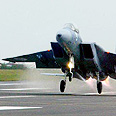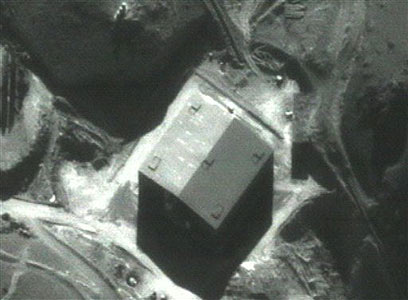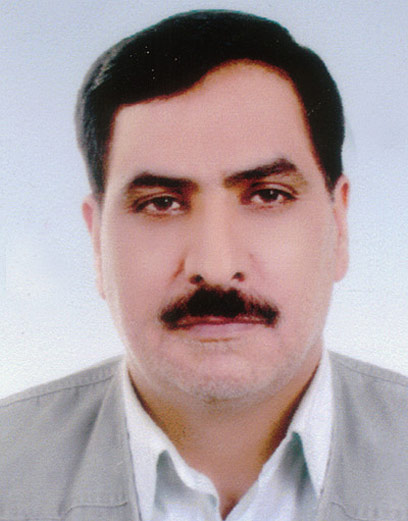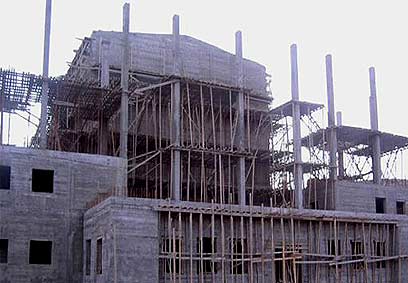
The long road to Syria
Ynetnews special: New book reveals full story behind bombing of Syrian reactor by Israel
The moment he left the hotel, two men rose from their seats at the corner of the lobby. They stepped into the elevator, reached the guest's room, and opened the door using keys. They searched the room professionally but did not need to work too hard. The Syrian's laptop was right on the desk. The two men installed a Trojan Horse - spyware that created a "backdoor" to the computer. Using this door, it became possible to monitor the computer remotely and copy all the material saved on it. Within minutes, the two men left the room.
The above story, and the information to follow, is based on both foreign and Israeli reports. The laptop provided Mossad with invaluable information, which for the first time exposed Syria's secret nuclear program. The findings were stunning: The blueprints of a nuclear reactor in the Dir al-Zur area; correspondence with North Korean officials; photographs showing the reactor covered with cement. The evidence was unequivocal. It complemented other information accumulated during 2006 and 2007 by Israel's top intelligence officials. According to this information, the Syrian government secretly built a nuclear reactor in the desert, near the Turkish border and roughly 100 miles from the Iraq border. Officials were surprised to discover that the reactor was constructed with Iranian funding and with the help of North Korean experts.

Image of Syrian reactor (Photo: AP)
The "love affair" between Syria and North Korea started with the Korean prime minister's visit to Syria before the Gulf War, on then-President Hafez Assad's invitation. The two countries signed a military and technological cooperation agreement. Although the nuclear issue was brought up, Assad decided to put it aside and make do with developing chemical and biological weapons. During his father's funeral in June 2000, Bashar Assad met with members of the North Korean delegation. At that time, they started to secretly push forward the construction of the Syrian reactor. In July 2002, a three-way deal was finalized, with an Iranian representative pledging to finance the reactor's construction (roughly $2 billion.) As it turns out, for five years Israel's and America's intelligence agencies were in the dark.
Iranian general tells all
During those years, some warning signs emerged, yet nobody took notice. The American intelligence community misinterpreted the information it received, while Mossad and Military Intelligence officials in Israel estimated that the Syrians have no interest in or ability to acquire nuclear weapons. Hence, nobody bothered to look for information that would shatter the "conception." The Syrians adopted another tactic meant to lull Israel and the US into a false sense of security: They enforced a complete communication moratorium on all employees and experts at the nuclear site. Cellular and satellite phones were banned, and all communication was undertaken via messengers. The activity at the site was not exposed even though American and Israeli satellites photographed it regularly. However, a subsequent dramatic development stunned both Israel and the US.
Iranian General Askari
On February 7, 2007, Iranian General Ali Reza Askari, formerly a senior Revolutionary Guard official and deputy defense minister, arrived in Damascus from Tehran. He stayed in the Syrian capital until he ensured his family was on its way out of Iran, before continuing to Turkey and disappearing in Istanbul. A month later, it turned out that Askari defected to the West in an operation planned by the US in conjunction with Israel. He was questioned in a US base in Europe – apparently in Germany – and revealed some of Tehran's and Damascus' deepest secrets. Askari exposed the three-way relationship involving Syria, North Korea, and Iran. He told his interrogators that Tehran was encouraging and funding the establishment of the Syrian nuclear reactor. He provided further details about the reactor's condition and about the Iranians assisting and advising the Syrians.
Agent inside the reactor
The information prompted Israel to go into operational alert. The Mossad earmarked manpower and resources to verify the details provided by the Iranian general. Then-Prime Minister Ehud Olmert convened Israel's security chiefs for a special meeting; during the session they agreed that Israel must act urgently to acquire credible proof of the reactor's existence. It was clear to all that Israel could not accept the prospect of Syria, its bitter, belligerent rival, turning into a nuclear power. Within a few months, Mossad and Military Intelligence chiefs were able to present the prime minister with the incriminating evidence he sought. Five months after Askari's defection, the search took its next turn: The material uncovered in the Syrian official's computer in London. Meanwhile, Mossad registered another success: It managed to recruit one of the reactor's employees, who provided numerous photographs and a video shot inside the building gradually taking shape.Israel made sure to update the US, in real-time, about all the material it managed to acquire, including up-to-date satellite images and tapped conversations between North Korea and Damascus. Israeli pressure also prompted the US utilize its own spy satellites. Soon, up-to-date material was accumulated including images elicited through America's advanced satellites and materials acquired via electronic means, showing that the Syrians were building the reactor rapidly.

Reactor under construction (Photo: AFP)
In June 2007, PM Olmert traveled to Washington to present all the material gathered by Israel; at the conclusion of a lengthy discussion with President George W. Bush, Olmert informed the US president that he decided to strike the Syrian reactor. The Americans were still hesitant, however. Israel recommended a military strike, but the US refused. According to credible American sources, the White House eventually decided that "the US prefers not to strike." Secretary of State Condoleezza Rice and Secretary of Defense Robert Gates attempted to convince Israel to confront the Syrians, but not to attack.
In July 2007, Israel held aerial patrols above the reactor and elicited images of the activity at the site via satellite Ofek 7. The images were analyzed by American and Israeli experts, who ruled that Syria is building a nuclear reactor based on the North Korean model. In fact, the experts reached the conclusion that the reactors were identical. Meanwhile, Israel's intelligence-gathering Unit 8200 provided records of conversations between Syrian scientists and North Korea experts. This information was also handed over to Washington, but the Americans demanded unequivocal proof that the facility will be used as a nuclear reactor, and that nuclear materials are already at the site. Israel decided to supply this information as well.
Behind enemy lines
The "smoking gun" was found in August 2007. The clear-cut evidence was acquired by the elite Sayeret Matkal reconnaissance unit, which headed to the site under cover of darkness on board two helicopters. Nobody spotted the troops as they landed near Dir al-Zur. Using specialized equipment, they took several soil samples that contained radioactive materials. The findings were urgently relayed to US National Security Advisor Stephen Hadley, who was stunned by the revelations. He quickly summoned top experts to draw conclusions and report to President Bush during their morning meeting.Following the expert assessment, Hadley was convinced the matter at hand was serious. He held a lengthy discussion with Israel's Military Intelligence and Mossad chiefs, thereby reaching the conclusion that the reactor constitutes a substantive threat. The US was convinced that the reactor should be destroyed. According to the British Sunday Times, PM Olmert then convened Defense Minister Ehud Barak and Foreign Minister Tzipi Livni; the three leaders discussed the expected implications of a military strike in Syria with top security officials. After hours of deliberations, they decided to go ahead and wipe out the reactor. Olmert informed Opposition Chairman Benjamin Netanyahu of the decision.

F-15 fighter jet taking off (Photo: Reuters)
The strike date was set for September 5, 2007. According to the Sunday Times, elite Air Force troops were deployed in the area on September 4 to mark the targets for the jets using laser. On September 5, 2007, at 11 pm, 10 fighter jets left the Air Force base in Ramat-David and headed towards the Mediterranean. Thirty minutes later, three planes were ordered to turn back. The other seven F-15 jets were ordered to head to the Syrian-Turkish border. En route to the reactor, they bombed a radar station in order to thwart Syria's ability to identify the infiltration. A few minutes later, the jets reached the Dir al-Azur area: They fired Maverick missiles and dropped half-ton bombs at the nuclear facility, recording direct hits. Within minutes, a Syrian reactor that could have been used to produce bombs that would threaten Israel's existence was wiped out.
Officials in Israel feared a Syrian response. PM Olmert called Turkish Prime Minister Erdogan and asked that the latter relay a message to President Assad, stressing that Israel was not seeking war. The next day, great confusion prevailed in Damascus. At first, the Syrians maintained complete silence. They reported the strike only at 3 pm. According to the report, Israeli jets infiltrated Syrian airspace at 1 am. "Our Air Force forced them to withdraw after they dropped ammunition over the desert; no injuries or damages were reported," the Syrians said.
In April, 2008, some seven months after the Syrian facility was hit, the US Administration announced that the bombed site was a nuclear reactor built with the help of North Korea and was not meant for peaceful purposes. American intelligence chiefs presented Congress members with photographs highlighting the Syrian facility's similarity to the North Korean reactor, as well as satellite images and sketches. Congress members also watched another fascinating video, which according to reports from Washington was filmed by a Mossad agent inside the Syrian reactor. Israel managed to keep quiet for two weeks, refusing to admit it was behind the strike. But then came Netanyahu, who, as opposition leader, who in response to a question by TV anchor Haim Yavin said, "When the government does something for Israel's security – I support it… And here I was a partner in this matter and I supported it from the very start." Olmert's aides were furious. "We are completely shocked by this man, he is irresponsible and lacks discretion; this is the real Bibi!" one aide said.
Assassination in Syria
On the evening of August 2, 2008, 11 months after the bombing of the reactor, a festive dinner was held on the terrace of a summer house in Rimal al-Zahabiya, north of the Syrian city of Tartous. The summer house was adjacent to the shore and had a magnificent view. The terrace overlooked the sea and served as a refuge from the summer's high humidity. The guests were close friends of the house's owner, General Mohammed Suleiman, who had traveled there for a weekend break.
Suleiman was President Assad's top aide on military and security matters. He was in charge of the reactor's construction and its security. Government circles in Damascus referred to him Assad's shadow. His office was located in the presidential palace, next to Assad's, and few knew him in Syria and abroad. While Suleiman's name was not mentioned in the media, Mossad and Western intelligence agencies knew him and his actions well. The 47-year-old Syrian was an engineering graduate of Damascus University. During his studies he befriended Basil Assad, then-President Hafez Assad's firstborn son and Bashar Assad's older brother. After Basil's death in a road accident, his father was sure to bring Suleiman close to himself and his heir. In 2000, Hafez Assad died and his son Bashar was elected president. With his rise to power, the young president made Suleiman his confidant and close advisor.
Suleiman played a unique role: He was a member of the Syrian research board, which dealt with the development of missiles, chemical and biological weapons and nuclear research and development. As part of his job, he was Syria's contact with North Korea. He coordinated the transfer of the reactor's parts to Syria and was in charge of security arrangements for the North Korean scientists and technicians involved in its construction. The reactor's bombing was a serious blow for Suleiman, but not a lethal one. After overcoming the initial shock, he began to plan the construction of an alternate reactor, for which a location had yet to be determined. Suleiman's new mission was much more complex and difficult than before, since he was now aware that he was on the Israeli and American intelligence agencies' radars.
Ahead of the next phase of his secret mission, Suleiman took a few days off and traveled to his summer home. A vacation and dinner with his friends was the best medicine for the pressure he was under. From his seat by the table he watched the waves lazily crawling up the shore. But what he didn't see, at a distance of some 150 meters (165 yards) from the terrace, was two figures waiting, motionless in the dark water. They reached this point from a far off distance in a ship that dropped them off some two 2 kilometers (1.2 miles) from Suleiman's house. From there they dived until they neared his home. The two were professional snipers, possessing a wealth of experience and nerves of steel. They carried their weapons in water-proof covers. When they reached the shore they immediately spotted Suleiman's house. The information they received from their country's intelligence agency was accurate. They identified the building and the terrace, scanned the people seated at the table and focused on their target: The general sitting opposite them, among his guests.
Around 9 pm the snipers returned to test their aim and range. They watched Suleiman, sitting on a chair at the center of the table surrounded by his friends. It was crowded around the table, which forced the snipers to reset their focus and aim at the host's head. They continued to hide in the water. Then the signal was given. The two emerged from the water to the shore, moved closer to the house, aimed their rifles and shot Suleiman simultaneously. The hit was lethal. His head was first jolted back and then collapsed forward on the table. Those present did not understand what had happened, because they didn't hear a sound – the rifles were equipped with silencers. Only after they noticed the blood flowing from Suleiman's head did they realize he had been shot. A commotion broke out on the terrace, which enabled the snipers to flee via a pre-planned escape route. The Sunday Times reported a slightly different version, saying the snipers were IDF Flotilla 13 commandoes who arrived in Tartous on a luxury yacht belonging to an Israeli businessman, carried out their mission, and vanished.
Syria's official bodies were shocked. The government initially kept quiet and did not address the reports of an assassination. There was much embarrassment. How did the hit team make it to northern Syria? How did it flee the site? Was there no place left in Syria where the regime's heads could feel safe? Days after the incident a brief official statement was released saying, "Syria is holding an investigation to find those responsible for this crime." But Arab media extensively reported on the affair from day one and raised speculations about the identities of the perpetrators. Arab newspapers focused on elements that had an interest in assassinating the general, and were quick to point to Israel. They also claimed that Israel carried out the assassination because of Suleiman's involvement in the construction of the reactor Dir al-Zur. While Arab media sang Suleiman's praises, Western intelligence agencies had a completely different reaction to his death. In the capitals of the free world, no one shed a tear over the general's untimely passing.
Article written by Michael Bar-Zohar and Nissim Mishal, authors of recently released book "Mossad – The Great Operations."
- Follow Ynetnews on Facebook










